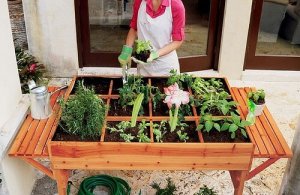How to Set up an Urban Organic Vegetable Garden

An organic vegetable garden can provide us with a great variety of fruit and vegetables to eat. Some people see it as a type of therapy, others as a way to communicate with nature, and others because they want to eat more healthily and naturally.
Here are some tips for setting up an organic vegetable garden, even if you happen to live in the city.
Read more: 8 Tips to Help You Eat More Vegetables
An organic garden: how to begin
In order to start an urban vegetable garden, where we can grow food that our family can eat, we need a small space on a terrace, balcony or in the garden. Here are some recommendations:
- The space must receive at least 6 hours of direct sun, so that the plants can grow well
- Any plant pots should face south, in order to receive the most light possible
- If a lot of space is available for the garden, it’s a good idea to cover it with a shade cloth so that your pets can’t get in

- Make sure you place the garden near a water supply to make it easier to water
- The number of plant pots or containers that you use will depend on the number of people in your family
- Plant the vegetables and fruits that your family likes to eat the most. Make sure they’re suitable to grow in your particular climate
Choose the right containers for the garden
The plant pots or containers should:
- Be light so that you can easily move them and so they are not too heavy for a balcony or terrace.
- Have good drainage so extra water from the rain or watering can drip out.
- Be as big as possible, so the plant roots can grow well, as if they were in the soil of an ordinary garden. A depth of 20 cm is recommended.

- Make sure you choose different sized pots for leaf vegetables and root vegetables, because they grow to be different sizes.
- Materials: wooden or ceramic pots protect roots better.
Defining your vegetable garden
It’s important to decide where you’ll put your vegetable garden. Also, do some research into the different plants you’d like to have there. Next, buy the pots or containers that you’ll need. It should be in a place that’s comfortable to work in, with good access to all the plants and vegetables.
The soil that you find at any gardening store is great, but it’s important to add some subsoil (you can buy that too), so that the plants grow well.

This text is provided for informational purposes only and does not replace consultation with a professional. If in doubt, consult your specialist.








